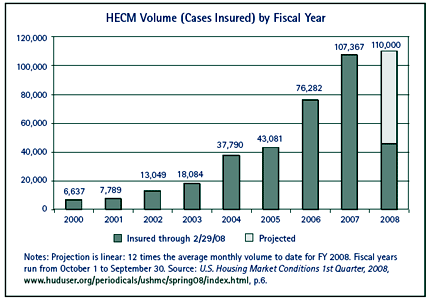September 2008
In this Issue
Untangling the Sources of Mortgage Closing Costs
HECM Program: Coming Into Its Own
Energy Efficiency Inside and Out
Every Picture Tells a Story: Data Images of Subsidized Households
In the next issue of ResearchWorks
HECM Program: Coming Into Its Own
The Home Equity Conversion Mortgage (HECM) program, a Federal Housing Administration (FHA) initiative that insures reverse mortgages for elderly homeowners, is likely to grow dramatically over the next two decades as aging baby boomers produce an annual bumper crop of seniors newly eligible for the program. According to Harvard University's Joint Center for Housing Studies, the number of owner heads of households aged 60 – 69 will increase by 53 percent between 2005 and 2015. Will reverse mortgages become mainstream among this growing cohort of older consumers, helping them cope with everyday expenses, home improvements, or medical bills while aging in place? An analysis in the first-quarter issue of U.S. Housing Market Conditions (USHMC) suggests that this may be the case.
Starting as a pilot program in 1989, HECM (also known as the FHA reverse mortgage program) became permanent in 1998. Growth was slow at first. Annual numbers of HECM loans remained below 8,000 until 2002 and then began to rise quickly. In 2007, approved loans rose from 76,282 in the previous year to 107,367. In 2008, the number of approved loans is expected to reach 110,000, totaling over 390,000 loans since the program began.

HECM loans are designed to help elderly homeowners (many of whom find themselves house rich but cash poor) access the equity in their homes without having to sell or move. A reverse mortgage converts home equity to cash, structuring the payouts to homeowners in various ways. Payments can be made in a lump sum, in monthly installments, or as a flexible line of credit. About three-fourths of HECM borrowers choose this last option. HECM borrowers make no repayment as long as at least one borrower resides in the home. Loan recipients or their estate must pay the full value of the loan — principal plus interest — to the lender after the last living borrower dies, sells, or moves away.
A commercial lender makes the HECM loan; the government's primary role is to insure it. FHA stipulates the amount of money to be lent in each case — a principal limit based on the borrower's age, the value of the home, and current interest rates. HUD also caps the loan according to a calculation based on either the value of the home or the FHA loan limit for the local area, whichever is less. HUD supports referral networks of housing counselors and requires a certificate of counseling from borrowers that confirms an understanding of how a reverse mortgage works and that less costly alternatives exist.
HECM loans offer significant advantages for both borrowers and lenders. Borrowers gain a government-guaranteed stream of income based entirely on their homes' equity; other assets, income, or debts are not considered. Unlike a commercial second mortgage or home equity line of credit, a HECM loan creates no pressure for repayment during the homeowners' tenure. Income from HECM is tax free, although it may count against eligibility for some means-tested programs. FHA ensures that lenders will receive the full value of the loan at term regardless of any possible changes in property values, which lowers risk and makes better loan terms possible.
On the downside, a reverse mortgage is a relatively expensive borrowing mechanism. A reverse mortgage uses up the equity in a home, and interest continually accrues to the household's debt. Unlike a traditional mortgage, HECM loan interest is not tax deductible until the time of payoff. Also, owners of homes exceeding HECM value guidelines will be constrained by HUD's limits on the principal.
The recent housing crisis has heightened sensitivities concerning nontraditional mortgage arrangements. The USHMC analysis assures readers that HECM is financially sound, "subject to all the numerous laws and federal accounting guidance that govern the risk management and reporting for all government loan guaranty programs." HECM is designed to incur no credit subsidy (operating loss) and to use conservative assumptions on changes in property values, thereby bolstering the program's stability.
HECM-insured loans now dominate the reverse mortgage market, with a share ranging from 85 to 95 percent since 2006. The secondary market for HECM loans has begun to broaden its investor base, which should mean lower borrowing costs and additional product innovations. Until 2006, Fannie Mae purchased nearly all HECM loans. Recently, however, Ginnie Mae launched a HECM-backed security. In addition, since 2007, HUD has allowed adjustable-rate HECM loans to be indexed to the London Interbank Offered Rate (LIBOR).
These developments, coupled with demographic-fueled demand, suggest that reverse mortgage lending — and HECM-backed loans in particular — will grow sharply over the next several years. The complete analysis is available at www.huduser.gov/periodicals/ushmc/spring08/index.html. Free print copies of the report can be ordered by calling HUD USER at 800.245.2691, option 1.
 Orange County, California, the nation's fifth largest county and home to three of its busiest amusement parks, is the focus of a recent Comprehensive Housing Market Analysis (CHMA). Readers will find that, while sales in the market declined from June 2006 through June 2007, the price of existing single-family homes increased by 6 percent, to $734,000. Additionally, the overall rental vacancy rate remained low (3.6 percent), despite a reported 6-percent rent increase during that same time period. This report describes economic, demographic, and housing inventory characteristics from 1990 to 2000, from 2000 through June 2007, and projections from July 1, 2007 to July 1, 2010. Similar CHMAs covering housing markets across the nation are available as free downloads at www.huduser.gov/publications/econdev/mkt_analysis.html. Orange County, California, the nation's fifth largest county and home to three of its busiest amusement parks, is the focus of a recent Comprehensive Housing Market Analysis (CHMA). Readers will find that, while sales in the market declined from June 2006 through June 2007, the price of existing single-family homes increased by 6 percent, to $734,000. Additionally, the overall rental vacancy rate remained low (3.6 percent), despite a reported 6-percent rent increase during that same time period. This report describes economic, demographic, and housing inventory characteristics from 1990 to 2000, from 2000 through June 2007, and projections from July 1, 2007 to July 1, 2010. Similar CHMAs covering housing markets across the nation are available as free downloads at www.huduser.gov/publications/econdev/mkt_analysis.html. |

